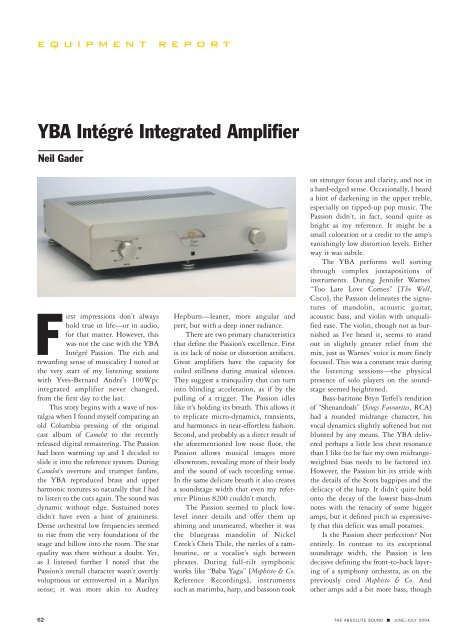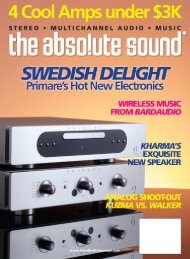Absolute Sound
Absolute Sound
Absolute Sound
You also want an ePaper? Increase the reach of your titles
YUMPU automatically turns print PDFs into web optimized ePapers that Google loves.
equipment report<br />
YBA Intégré Integrated Amplifier<br />
Neil Gader<br />
First impressions don’t always<br />
hold true in life—or in audio,<br />
for that matter. However, this<br />
was not the case with the YBA<br />
Intégré Passion. The rich and<br />
rewarding sense of musicality I noted at<br />
the very start of my listening sessions<br />
with Yves-Bernard André’s 100Wpc<br />
integrated amplifier never changed,<br />
from the first day to the last.<br />
This story begins with a wave of nostalgia<br />
when I found myself comparing an<br />
old Columbia pressing of the original<br />
cast album of Camelot to the recently<br />
released digital remastering. The Passion<br />
had been warming up and I decided to<br />
slide it into the reference system. During<br />
Camelot’s overture and trumpet fanfare,<br />
the YBA reproduced brass and upper<br />
harmonic textures so naturally that I had<br />
to listen to the cuts again. The sound was<br />
dynamic without edge. Sustained notes<br />
didn’t have even a hint of graininess.<br />
Dense orchestral low frequencies seemed<br />
to rise from the very foundations of the<br />
stage and billow into the room. The star<br />
quality was there without a doubt. Yet,<br />
as I listened further I noted that the<br />
Passion’s overall character wasn’t overtly<br />
voluptuous or extroverted in a Marilyn<br />
sense; it was more akin to Audrey<br />
Hepburn—leaner, more angular and<br />
pert, but with a deep inner radiance.<br />
There are two primary characteristics<br />
that define the Passion’s excellence. First<br />
is its lack of noise or distortion artifacts.<br />
Great amplifiers have the capacity for<br />
coiled stillness during musical silences.<br />
They suggest a tranquility that can turn<br />
into blinding acceleration, as if by the<br />
pulling of a trigger. The Passion idles<br />
like it’s holding its breath. This allows it<br />
to replicate micro-dynamics, transients,<br />
and harmonics in near-effortless fashion.<br />
Second, and probably as a direct result of<br />
the aforementioned low noise floor, the<br />
Passion allows musical images more<br />
elbowroom, revealing more of their body<br />
and the sound of each recording venue.<br />
In the same delicate breath it also creates<br />
a soundstage width that even my reference<br />
Plinius 8200 couldn’t match.<br />
The Passion seemed to pluck lowlevel<br />
inner details and offer them up<br />
shining and unsmeared, whether it was<br />
the bluegrass mandolin of Nickel<br />
Creek’s Chris Thile, the rattles of a tambourine,<br />
or a vocalist’s sigh between<br />
phrases. During full-tilt symphonic<br />
works like “Baba Yaga” [Mephisto & Co,<br />
Reference Recordings], instruments<br />
such as marimba, harp, and bassoon took<br />
on stronger focus and clarity, and not in<br />
a hard-edged sense. Occasionally, I heard<br />
a hint of darkening in the upper treble,<br />
especially on tipped-up pop music. The<br />
Passion didn’t, in fact, sound quite as<br />
bright as my reference. It might be a<br />
small coloration or a credit to the amp’s<br />
vanishingly low distortion levels. Either<br />
way it was subtle.<br />
The YBA performs well sorting<br />
through complex juxtapositions of<br />
instruments. During Jennifer Warnes’<br />
“Too Late Love Comes” [The Well,<br />
Cisco], the Passion delineates the signatures<br />
of mandolin, acoustic guitar,<br />
acoustic bass, and violin with unqualified<br />
ease. The violin, though not as burnished<br />
as I’ve heard it, seems to stand<br />
out in slightly greater relief from the<br />
mix, just as Warnes’ voice is more finely<br />
focused. This was a constant trait during<br />
the listening sessions—the physical<br />
presence of solo players on the soundstage<br />
seemed heightened.<br />
Bass-baritone Bryn Terfel’s rendition<br />
of “Shenandoah” [Sings Favourites, RCA]<br />
had a rounded midrange character, his<br />
vocal dynamics slightly softened but not<br />
blunted by any means. The YBA delivered<br />
perhaps a little less chest resonance<br />
than I like (to be fair my own midrangeweighted<br />
bias needs to be factored in).<br />
However, the Passion hit its stride with<br />
the details of the Scots bagpipes and the<br />
delicacy of the harp. It didn’t quite hold<br />
onto the decay of the lowest bass-drum<br />
notes with the tenacity of some bigger<br />
amps, but it defined pitch so expressively<br />
that this deficit was small potatoes.<br />
Is the Passion sheer perfection? Not<br />
entirely. In contrast to its exceptional<br />
soundstage width, the Passion is less<br />
decisive defining the front-to-back layering<br />
of a symphony orchestra, as on the<br />
previously cited Mephisto & Co. And<br />
other amps add a bit more bass, though<br />
62 THE ABSOLUTE SOUND ■ JUNE/JULY 2004










